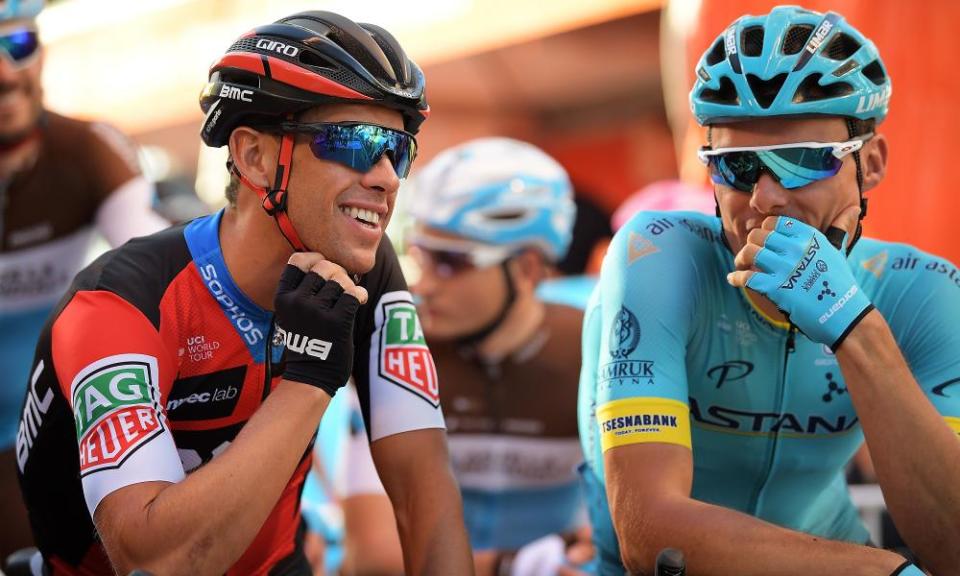Australians prepare for a bumper year starting with Tour Down Under | Kieran Pender

Nothing seems amiss on the sunny streets of Adelaide. The professional peloton has arrived in Australia to begin another year of the UCI World Tour, with the usual circus of sponsors and supporters in tow. Coffee shops are full of lycra-clad riders, the temporary Tour Down Under village is humming with activity and charismatic world champion Peter Sagan is wowing crowds. While some pageantry is expected to celebrate the 20th anniversary of the Tour, it is otherwise business as usual for Australia’s biggest road race.
But 2018 is not just another year for the nation’s cyclists. A packed calendar in Australia and across the globe promises a mix of challenges and opportunities for riders. The same can be said of those labouring in the back-room, with reform and renewal taking place within the sport’s peak body, its high performance unit and the only Australian-registered World Tour team. In a variety of ways, 2018 could prove to be a pivotal year for cycling in this country.
When road racing action gets underway on Tuesday with stage one of the Tour Down Under, the Commonwealth Games will be the elephant in the room. The sporting extravaganza’s timing is highly problematic for Australian cyclists: early April is midway through the Spring Classics in Europe and too close to the Giro d’Italia for most to risk a detour back home. At the recent Road National Championships in Ballarat, high-profile rider after high-profile rider admitted that they would not feature on the Gold Coast’s roads. While the women’s squad is expected to be led by 2017 national champion Katrin Garfoot, selectors of the male contingent face a vastly-reduced talent pool.
It is on the track, though, that Australian cycling faces an important test. Long at the forefront of Australia’s Olympic hopes, the track squad fared poorly in Rio de Janeiro; one silver medal and one bronze falling well short of the public’s expectations, and those of their funders at the Australian Sports Commission. Significant overhaul followed: a new high performance director was recruited from arch-rivals Great Britain, riders retired and coaches were replaced. Australia fared better at the 2017 Track World Championships, topping the medal tally, but it will be on the newly-built Anna Meares Velodrome that the progress of this reform is measured. Commonwealth Games gold medals are a necessity.
Attention will then turn to Europe for Grand Tour season. Australia’s sole World Tour outfit Mitchelton-Scott has announced its Colombian star Esteban Chaves is targeting the Giro d’Italia general classification battle. After finishing an agonising second in 2016, “Aussie Esteban” will be among the pre-race favourites. While Giro success for a Colombian might not match Cadel Evans’ 2011 Tour de France triumph in the pantheon of great Australian cycling moments, Grand Tour glory would represent a remarkable achievement for the Gerry Ryan-funded Mitchelton-Scott.
It will be at the 105th Tour de France that a slender Tasmanian will have the opportunity to equal Evans’ iconic victory. Richie Porte might be the unluckiest man in cycling: attempt after attempt at the yellow jersey have been denied by misfortune and mishaps. Last year, the BMC Racing Team rider appeared in imposing form when he crashed out in a horrific manner on stage nine. Almost 33, the window for Porte to secure the most sought-after jersey in world cycling is closing fast.
Porte has recovered well from his injuries, and showed strong early season form during attacks up Mount Buninyong on his way to 14th at the national championships. Joined by a fearsome BMC team at the Tour Down Under – Porte, Simon Gerrans and Rohan Dennis collectively hold six winner’s jerseys between them – he is a short-priced favourite to win the World Tour opener.
With the Tour de France participation of friend and rival Chris Froome clouded by a failed drugs test, and a number of other yellow jersey contenders instead eyeing the Giro, the stars may align mid-year for Porte to claim world cycling’s biggest prize. Add in the Tour de France debut of Sydney sprint sensation Caleb Ewan, and Australian fans are in for an enthralling month of late nights on the couch.
Off the road, peak body Cycling Australia (CA) continues its attempts to stabilise after serious financial difficulties earlier in the decade. The much-maligned domestic competition, CA’s National Road Series (NRS), is also undergoing reform. The decision to divide it up into segments, delineating criteriums, one-day races and lengthier tours on the calendar, may see the NRS prosper. While the year-long string of events has helped countless Australian riders graduate to the World Tour (including Porte, who began his career with an early iteration of NRS mainstays Bennelong SwissWellness), underlying structural dilemmas remain unaddressed.
One bright spot for CA and Australian cycling fans has been the continued growth of women’s cycling, at both a participation and elite level. The depth of the female peloton was underscored by Shannon Malseed’s unexpected national title win earlier in the month, and the women’s Tour Down Under – won for the second consecutive year on Sunday by Mitchelton-Scott stalwart Amanda Spratt – continues to expand. The decision to add a women’s edition to the oldest stage race in Australia, the forthcoming Herald Sun Tour, adds further momentum.
A busy 12 months awaits all of the sport’s Australian stakeholders. Enjoying a brief moment of respite in an Adelaide hotel lobby ahead of the Tour Down Under, a wide smile appears on the face of Mitchelton-Scott’s typically-reserved general manager Shayne Bannan. He may have been involved in Australian cycling for three decades, but even Bannan is enthused: “It is an exciting year ahead.”

 Yahoo Sport
Yahoo Sport 





































